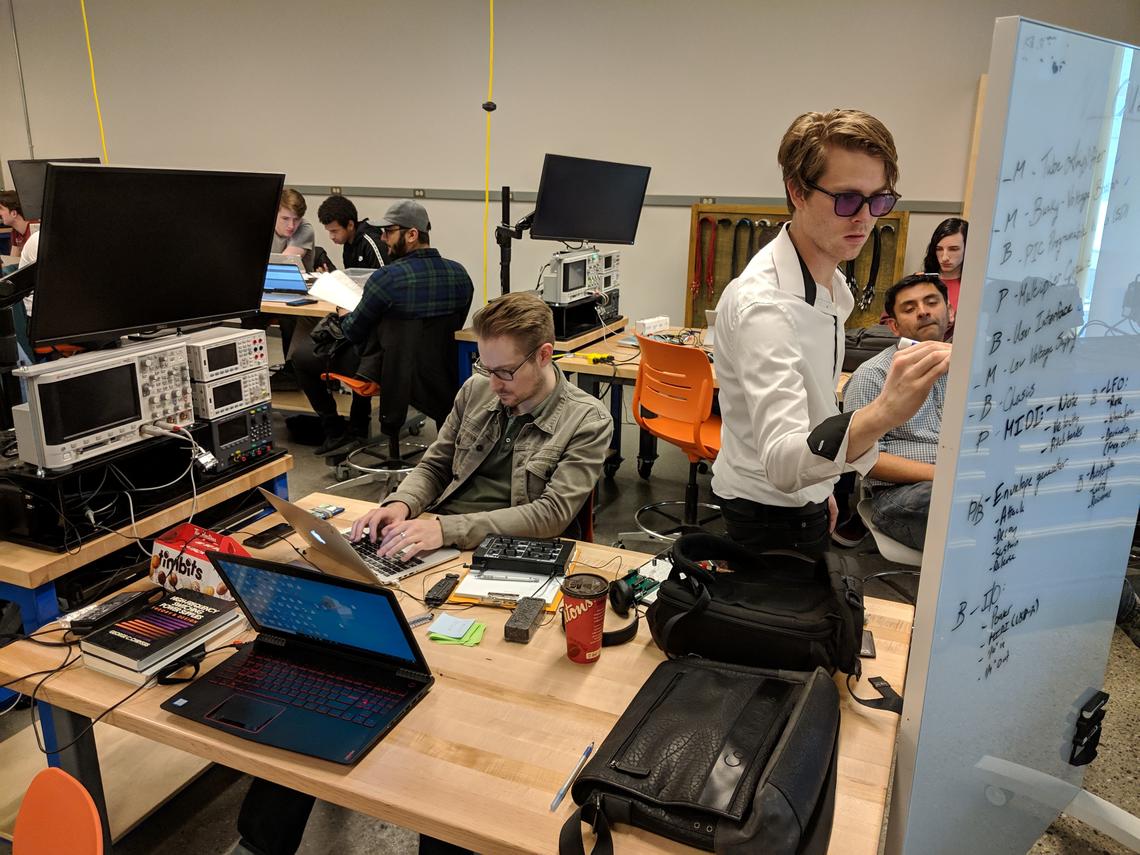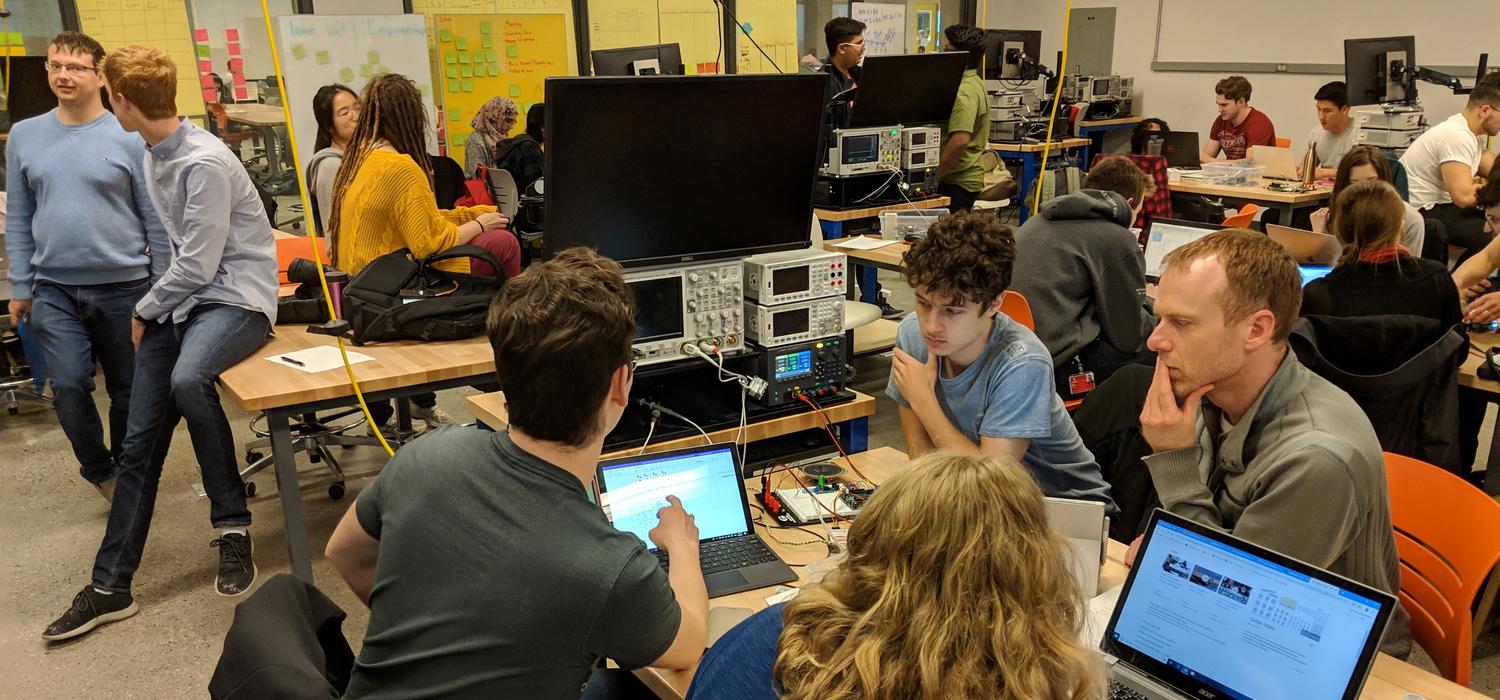
Students hard at work in the Integrated Learning Stream classroom in 2019.
Dr. Mike Potter
July 16, 2021

What started out as an innovative way to educate engineers took on a whole new meaning over the past 18 months.
A successful pilot project in 2019 – based on the concept of an Integrated Learning System (ILS) – unified five courses into a single program of learning, leadership and collaboration. By 2020, the Schulich School of Engineering had doubled the size of this leading-edge program, but one thing stood in the way of its success: the COVID-19 pandemic.
What might have been viewed as a massive roadblock was turned into opportunity to try something different.
That innovation won accolades recently, receiving the Team Teaching award at the University of Calgary Teaching Awards.
How it started
The first cohort of 34 students, five instructors, eight teaching assistants and a technician set their sights on integrating five traditional electrical-engineering courses into one big experiment.
Not only was the content fused together into an Integrated Learning Stream, but schedules were made flexible, while the idea of a traditional university classroom was transformed.

Students hard at work in the Integrated Learning Stream classroom in 2019.
Dr. Mike Potter
Students worked on signals, circuits, electronics, computer organization and engineering design, tying it all together with a semester-long project.
Finding the right set-up on campus for this collaborative, student-learning experience was a challenge.
“We had a lack of rooms with a good studio setup to commandeer for the entire semester,” Dr. Mike Potter, PhD, said. “Although several such rooms exist, they are also a resource for many other courses across Schulich, so some juggling and compromise had to happen.”
How it changed
The program expanded to 72 students for Winter 2020, but was disrupted mid-term with the onset of the pandemic. It forced students online for a program that was centered on collaboration and teamwork.
“Although this was daunting, we found that the structure of ILS was quite resilient to this change,” Potter said. “Almost everything we could do in-person, we could do online - like student groups meeting in breakout rooms.”
The most difficult challenge teachers faced was not being onsite to troubleshoot equipment issues, but he says students were able to figure out most problems with kits they took home.
Instead of having to develop a working prototype, students were also allowed to deliver a concept design instead.
How it’s going
With the benefit of hindsight and new knowledge gained from what turned out to be a crash-course in implementing an ILS online, Potter says the department took advantage of the resiliency of the program structure by requiring all incoming electrical engineering students to take part in Winter 2021.
“We were ahead of the curve because most of us had flipped classroom material already created, and we had experience with how to manage everyone online,” he said. “One of the more remarkable things we were able to do was ensure that every single student, including the international cohort, had an electronics kit either picked up or delivered, so we could still have them do hands-on activities remotely.”
That planning and preparation paid dividends, as students were able to focus on the course-work but also on relationship-building.
“Learning, during the pandemic, without the collaboration and camaraderie that helped me succeed in my first year of engineering, was extremely difficult,” student Emily Knight said. “Luckily, the ILS team made it clear that the success and wellbeing of students was its priority.”
She credits the adaptability of the program with decreasing the pressure put on students, allowing them to understand the material better.
“The program is unique in that instructors work together to shape the experience for students while keeping innovation, curiousity and long-term learning a priority for the semester,” Nathalie Drzewiecki added. “The final project itself was invaluable, as it allowed me to link my passions for mental health along with technology.”
Rewarding experience
Each year, the University of Calgary hands out its teaching awards to recognize excellent contributions to teaching and learning.
Potter says the Integrated Learning Stream team, which includes Dr. Laleh Behjat, PhD, Dr. Kartik Murari, PhD, Dr. Seyed (Yani) Jazayeri, PhD, Dr. Geoff Messier, PhD, Dr. Rushi Vyas, PhD, Robyn Paul, Monique Sullivan, Kat Dornian and Jason Long, was humbled with the honour.
“The pandemic has really taught us the importance of learning in community,” he stated. “Our community included not just our instructor team, but the students as well. Even though we were all remote, it still felt like we were all learning together, which was really gratifying.”
Potter sees other departments and programs looking at ways of delivering the same kind of learning experience.
He also sees a few opportunities to improve things within the Integrated Learning Stream.
“One avenue that is high on our radar is trying to make a more conscious effort to deliver material in a more integrated way,” Potter said. “We have done a decent job of that so far, but really need to lift the hood and identify opportunities to highlight the integrated aspect of material.”
He and the team would also like to tackle some pedagogical research in engineering education.
As for the students, they believe the experience they gained was invaluable.
“The most important lesson I learned was the importance of resiliency in teamwork and engineering design,” Knight said. “The emotional intelligence fostered by the ILS team will help me, a future engineer, in any future career path I may choose to take, regardless of my academic strengths and weaknesses.
Drzewiecki agrees that having a multitude of skillsets will only help her in the future.
“This program is proof that engineering is inherently creative and multidisciplinary,” she added. “As I continue my engineering degree, I’m eager to focus on long-term learning and retention, and applying my technical skills to make an impact in my community.”